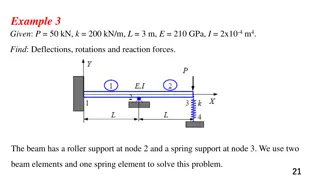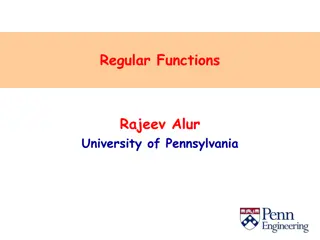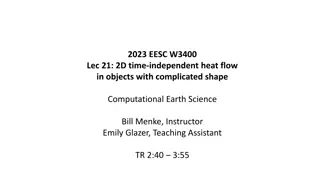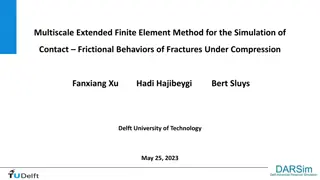An Overview of Finite Element Method in Mechanical Engineering
Finite Element Method (FEM) in mechanical engineering is a powerful numerical technique involving dividing a domain into finite elements, establishing relations between variables, and assembling elements to analyze a system. This method is fundamental for solving one-dimensional problems and approximating solutions while deriving the weak form. By following specific steps and utilizing weight functions, FEM allows for accurate analysis and modeling in mechanical systems.
Download Presentation

Please find below an Image/Link to download the presentation.
The content on the website is provided AS IS for your information and personal use only. It may not be sold, licensed, or shared on other websites without obtaining consent from the author. Download presentation by click this link. If you encounter any issues during the download, it is possible that the publisher has removed the file from their server.
E N D
Presentation Transcript
By By S S Ziaei Ziaei- -Rad Mechanical Engineering Department, IUT Mechanical Engineering Department, IUT Rad THE FINITE ELEMENT METHOD- A REVIEW
FEM BASIC FEATURES The finite element method has the following three basic features: 1. Divide the whole (i.e. domain) into parts, called finite elements. 2. Over each representative element, develop the relations among the secondary and primary variables (e.g. forces and displacements, heats and temperatures, and so on). 3. Assemble the elements (i.e. combine the relations of all elements) to obtain the relations between the secondary and primary variables of the whole system.
ONE DIMENSION PROBLEMS Consider Where a=a(x), c=c(x) and f=f(x) are known functions. u=u(x) is the unknown. A typical interval called finite element has a length of he and located between xa and xb.
FINITE ELEMENT APPROXIMATION A solution in the form of The solution should satisfy the differential equation and also the end condition over element.
FINITE ELEMENT APPROXIMATION The difference between 2 sides of equation is called residual One way is The set of weight functions must be linearly independent The set of weight functions must be linearly independent to have linearly independent algebraic equations. to have linearly independent algebraic equations. Weight function If = Galerkin Galerkin method method
DERIVATION OF THE WEAK FORM A three steps procedure A three steps procedure 1 1- - write the weighted write the weighted- -residual statement residual statement 2 2- -using differential by part trade the derivative using differential by part trade the derivative between the weight and approximation functions between the weight and approximation functions This is called weak form because it allows approximation function This is called weak form because it allows approximation function with weaker continuities. with weaker continuities.
DERIVATION OF THE WEAK FORM 3-examine the boundary term appearing in the weak form The BCs on primary variables are called Essential or Dirichlet BCs. The BCs on secondary variable are called Natural or Neumann BCs.
DERIVATION OF THE WEAK FORM In writing the final weak form The final expression is From mechanical point of view Q is the axial force.
REMARKS The weak form contains two types of expression (Product of u and w) Bilinear form Bilinear form (only w) Linear form Linear form They have the following properties
REMARKS The weak form can now be expressed Which is called the variational problem associated to the differential equation. B creates the element coefficient L creates the load vector
REMARKS The weak form is the statement of the principle of minimum potential energy. The work done by distributed applied force f and Point force Qs Elastic Strain Energy Stored in the bar
INTERPOLATION FUNCTION The approximation solution should be selected such that the differentiability of the weak form satisfied and also the end condition on primary variables. Since the weak form contain first-order derivatives, thus any polynomial of first degree and higher can be used.
LINEAR INTERPOLATION The first degree polynomial The polynomial is admissible if Linear Lagrange interpolation function
LINEAR INTERPOLATION Also Note that
QUADRATIC INTERPOLATION For a second degree polynomial
QUADRATIC INTERPOLATION where
FINITE ELEMENT MODEL The weak form Substituting
FINITE ELEMENT MODEL Where Force vector or source vector Coefficient matrix or stiffness matrix The equation has 2n unknowns
FINITE ELEMENT MODEL Some of these unknowns are from BCs The remaining by balance of secondary variable Q at common nodes Doing the integration
TWO DIMENSIONAL PROBLEMS The governing equation is The functions axx=axx(x,y), byy=byy(x,y) and f=f(x,y) are known functions. The following BCs are assumed
2D PROBLEMS
FINITE ELEMENT APPROXIMATION The domain is first divided into several subdomain The unknown u is approximated in an element
WEAK FORMULATION Step 1 Step 2- distribute the differential between u and w
WEAK FORMULATION Thus Secondary variable Secondary variable By definition qn is positive outward around the surface as we move counterclockwise around the boundary.
WEAK FORMULATION Step 3 Bilinear form Linear form
FINITE ELEMENT MODEL The weak form need u to be at least linear in x and y For Galerkin formulation
INTERPOLATION FUNCTION For convergence As linear approximation Triangular element For quadratic Rectangular element
LINEAR TRIANGULAR ELEMENT The linear interpolation function for 3 nodes triangular Lagrange interpolation function
LINEAR TRIANGULAR ELEMENT If along the element the functions a, b , f are constant Then For a right triangular element with base a and height b
LINEAR TRIANGULAR ELEMENT The evaluation of boundary integral Has two parts: 1- for interior edges they cancel out each other on neighboring elements (balance of internal flux) 2-the portion of boundary that within the , the integral should be computed.
LINEAR RECTANGULAR ELEMENT For a 4 nodes rectangular elements The Lagrangian interpolation functions are The integral should be evaluated on a rectangular of sides a and b
LINEAR RECTANGULAR ELEMENT For constant values of a,b,f over element
ASSEMBLY OF ELEMENTS Assembly has two rules Stiffness matrix of Triangular element Stiffness matrix of rectangular element Imposing the continuity of the primary variables for elements 1 and 2
ASSEMBLY OF ELEMENTS Balance of secondary variables The internal flux on side 2-3 of element 1 should be equal to the internal flux of side 4-1 element 2 In FE it means
ASSEMBLY OF ELEMENTS For element 1 (triangular element) For rectangular element
ASSEMBLY OF ELEMENTS Imposing balance, means 2nd equation (1)+1st equation (2) 3rd equation(1)+4th equation (2) Using local-global node number
HEAT CONDUCTION BY HEAT CONVECTION AT BOUNDARIES HEAT CONDUCTION BY HEAT CONVECTION AT BOUNDARIES When dealing with heat convection from boundary to the surrounding the FE model should be corrected. For such case the balance of energy is The previous equation is now
HEAT CONDUCTION BY HEAT CONVECTION AT BOUNDARIES HEAT CONDUCTION BY HEAT CONVECTION AT BOUNDARIES Or where
HEAT CONDUCTION BY HEAT CONVECTION AT BOUNDARIES HEAT CONDUCTION BY HEAT CONVECTION AT BOUNDARIES For no convective heat transfer elements hc=0 and the case is the same as before Indeed the contribution is only for elements whose sides fall on the boundary with specified convective heat conduction.
LIBRARY OF 2D ELEMENTS Two develop the case for general elements we consider master elements first. These masters can be used for elements with irregular shapes. This requires a transformation from irregular shape element to the master element.
TRIANGULAR ELEMENT First, define the area or natural coordinates
TRIANGULAR ELEMENT Linear and quadratic interpolation functions are Vertices nodes Vertices nodes Middle nodes Middle nodes
RECTANGULAR ELEMENT For a rectangular element, consider a local coordinate
RECTANGULAR ELEMENT For higher order
RECTANGULAR ELEMENT For serendipity element
NUMERICAL INTEGRATION In a complicated mesh, each element transformed to a master element The transformation between a typical element of the mesh and the master element is























